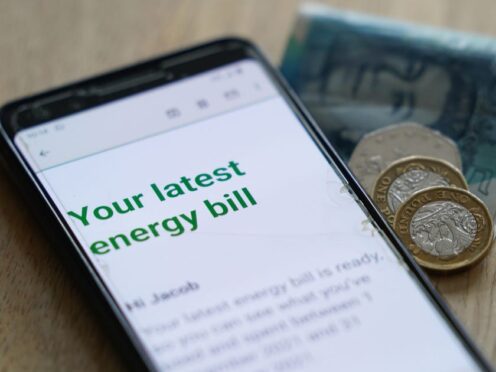Some 10 million households are being urged to send energy meter readings to their supplier this weekend to ensure they do not overpay when cheaper prices come into effect on July 1.
The average household energy bill will fall by 7% from next month after Ofgem lowered its price cap in response to wholesale prices.
The regulator is dropping the cap from the current £1,690 for a typical dual-fuel household in England, Scotland and Wales to £1,568, a drop of £122 over the course of a year.
This is around £500 less than the cap in July last year, when it was £2,074.
But those households on a standard variable tariff – as opposed to a fixed deal – and who do not have a smart meter should submit their electricity and gas readings to their supplier as close as possible to July 1 to ensure they are billed accurately at the lower prices.
Those who do not submit readings risk having some of their usage after that date charged at the previous, more expensive rates.
Suppliers who have not received meter readings base their bills on estimated usage, meaning households could be overpaying, while others may not be paying enough.
The average household is expected to spend £83 on energy in July, compared with £127 in June, due to the lower cap and lower usage due to warmer weather, comparison site Uswitch calculated.
The latest fall offers further relief to households given the previous quarter-on-quarter drop seen in April, but analysts have said they expect Ofgem to increase the price cap in October, before dropping it again in January 2025.
Ben Gallizzi, energy spokesman at Uswitch, said: “Households should be adding ‘read my energy meter’ to their to-do list this weekend if they want to take full advantage of lower energy prices from July.
“Customers who don’t have a smart meter should aim to submit their readings before or on Monday July 1, so their supplier has an updated – and accurate – view of their account.”
Uswitch also urged households to investigate other tariffs, including fixed deals, to beat the predicted October price hikes.
Mr Gallizzi said: “There are a number of fixed tariffs worth considering right now. By opting for a fixed deal, you’re locking in those rates for the duration – usually 12 months – which means households could have price certainty and avoid the ups and downs of the price cap.”
Meanwhile, a coalition of consumer groups and energy firms have urged Ofgem not to allow firms to shut out their existing customers from their cheapest deals.
Ofgem has said it is minded to remove the ban on acquisition-only tariffs, which have been used by firms to attract new customers or lure switchers from rival firms, from October 1.
Which? said it was concerned that households who wanted to stay with their current supplier could be left worse off by being hit with so-called “loyalty penalties”.
The watchdog has written to the regulator alongside E.ON, Octopus, So Energy, Rebel Energy, End Fuel Poverty Coalition, Citizens Advice and Fair By Design, calling for it to reconsider its proposals to lift the ban.
Rocio Concha, Which? director of policy and advocacy, said: “Our research has shown that consumers overwhelmingly believe cheaper energy deals only available to new customers are unfair – even when they might stand to benefit.
“That’s why Which? and a coalition of energy firms and consumer organisations have written to Ofgem warning them not to lift the ban on acquisition-only pricing.
“Allowing deals exclusively for new energy customers could open the door to loyalty penalties and would come at the expense of those who wish to stick with their current supplier on their best deal.”
An Ofgem spokesman said: “We are grateful to the consumer groups and stakeholders for their response to our statutory consultation.
“We appreciate the strength of feeling on this issue and will carefully consider all perspectives in the coming weeks to inform our final decision.”
